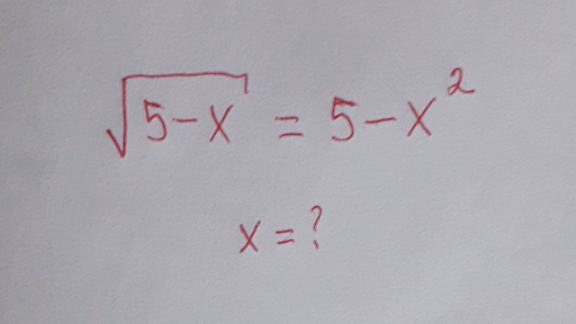Question Number 115986 by bemath last updated on 30/Sep/20

Answered by MJS_new last updated on 30/Sep/20

$$\sqrt{\mathrm{5}−{x}}=\mathrm{5}−{x}^{\mathrm{2}} \\ $$$$\mathrm{5}−{x}\geqslant\mathrm{0}\:\Rightarrow\:{x}\leqslant\mathrm{5} \\ $$$$\mathrm{5}−{x}^{\mathrm{2}} \geqslant\mathrm{0}\:\Rightarrow\:−\sqrt{\mathrm{5}}\leqslant{x}\leqslant\sqrt{\mathrm{5}} \\ $$$$\Rightarrow\:−\sqrt{\mathrm{5}}\leqslant{x}\leqslant\sqrt{\mathrm{5}} \\ $$$$\mathrm{squaring}\:\mathrm{both}\:\mathrm{sides} \\ $$$$\mathrm{5}−{x}=\left(\mathrm{5}−{x}^{\mathrm{2}} \right)^{\mathrm{2}} \\ $$$${x}^{\mathrm{4}} −\mathrm{10}{x}^{\mathrm{2}} +{x}+\mathrm{20}=\mathrm{0} \\ $$$$\left({x}^{\mathrm{2}} −{x}−\mathrm{4}\right)\left({x}^{\mathrm{2}} +{x}−\mathrm{5}\right)=\mathrm{0} \\ $$$${x}_{\mathrm{1}} =\frac{\mathrm{1}−\sqrt{\mathrm{17}}}{\mathrm{2}} \\ $$$${x}_{\mathrm{2}} =\frac{\mathrm{1}+\sqrt{\mathrm{17}}}{\mathrm{2}}>\sqrt{\mathrm{5}} \\ $$$${x}_{\mathrm{3}} =\frac{−\mathrm{1}−\sqrt{\mathrm{21}}}{\mathrm{2}}<−\sqrt{\mathrm{5}} \\ $$$${x}_{\mathrm{4}} =\frac{−\mathrm{1}+\sqrt{\mathrm{21}}}{\mathrm{2}} \\ $$$$\Rightarrow \\ $$$${x}=\frac{\mathrm{1}−\sqrt{\mathrm{17}}}{\mathrm{2}}\vee{x}=\frac{−\mathrm{1}+\sqrt{\mathrm{21}}}{\mathrm{2}} \\ $$
Commented by bemath last updated on 30/Sep/20

$${thank}\:{you}\:{prof} \\ $$
